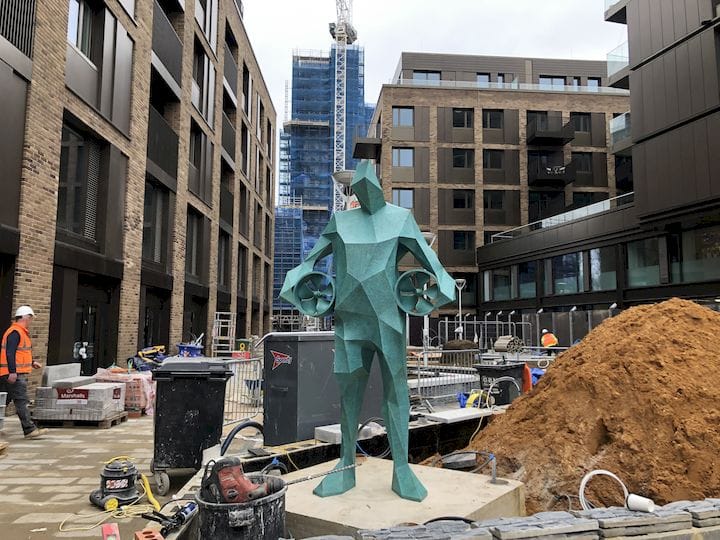![The 3D printed “Green Man” sculpture in London [Source: voxeljet]](https://fabbaloo.com/wp-content/uploads/2020/05/image-asset_img_5eb0987834f4a.jpg)
This week’s selection is the Green Man by voxeljet and the London Bronze Casting Company.
This 2.2-meter-tall sculpture stands in Deptford, London, just across the Thames river from Canary Wharf. The sculpture weighs approximately 200 kg.
The sculpture represents a typical worker, Bill, who exemplifies those who worked at a metal foundry that previously existed at the same site. The Green Man is holding a pair of metal impellers, which were a typical product produced at the foundry in the past.
After creating the 3D model of Bill using a combination of photogrammetry and CAD software, the next step was to produce the sculpture itself.
This was done by segmenting the model into several sections, each of which was first 3D printed on a voxeljet VX1000 PPB 3D printer at voxeljet’s manufacturing service in the UK. The material used was PMMA, an excellent material for the lost-wax casting process.
These PMMA “positives” were then coated with a ceramic material and then heated to burn out the PMMA. This left a cavity into which the liquid bronze could be poured and set.
Sections were then welded together and the entire sculpture was painted with a rather dramatic verdigris color. This unusual color was selected because that’s the color foundry workers would have acquired during the course of a work day.
![The Green Man sculpture’s dedication in London [Source: voxeljet]](https://fabbaloo.com/wp-content/uploads/2020/05/image-asset_img_5eb09878971f3.jpg)
There are two interesting things to learn from this fascinating sculpture project.
First, there really are no limits to the size of 3D printed objects. It is always feasible to segment the 3D model, print the segments, and assemble them afterwards. I cannot tell you how many times I am asked “How big can it print?” There is no answer to that question, as it really doesn’t make sense. This sculpture demonstrates that very clearly.
Secondly, this project shows the versatility of 3D printing as it is being used in an indirect manner; the final object was not printed, instead molds were 3D printed and then used to create the final object. This is a reminder that 3D printing is only one of many methods of making objects, and that the most interesting objects are usually created when you combine several methods together.
Via voxeljet











This week’s selection is a 3D printed Coronavirus!